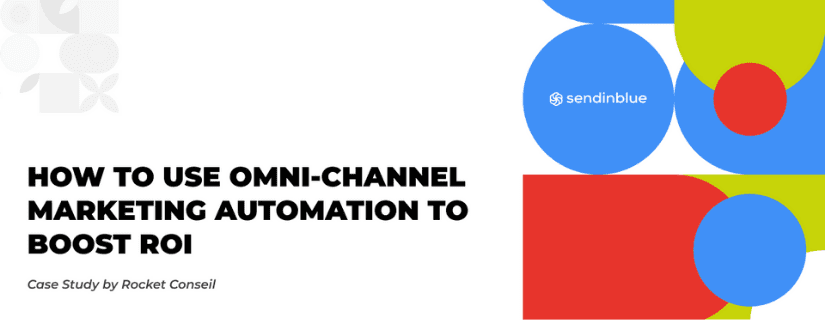

By Lillie Mazitova, Web & Ecommerce Project Manager @ Rocket Conseil
Rocket Conseil, a Paris-based web agency and official Sendinblue Expert Partner, has been helping La Fine Fleur boost ROI through omnichannel marketing since the launch of their e-shop in September 2019. In this article, get the inside scoop on how they set up Sendinblue automation workflows for best results.
La Fine Fleur is a French ecommerce website dedicated to sustainable fashion for men and children. Their products are eco-responsible, featuring only transparent and conscious fashion pieces.
Thanks to years of analyzing UX behavior and data, Rocket Conseil knows how to set up the perfect condition-based automated workflows. In this case study, discover how they used omnichannel marketing automation to boost ROI for La Fine Fleur and why Sendinblue is the perfect tool for that.
Benefits of using an omnichannel marketing platform
In 2021, Rocket Conseil became Sendinblue’s Admiral partner as part of their “Expert Program” but in fact it has been the agency’s number one choice for marketing communication software for its clients for several years prior to that.
As an agency, the fact that Sendinblue is an all-in-one platform (email, SMS, Facebook Ads, chat, and CRM) allows us to:
- Optimize our development efforts and save time. Instead of setting up each communication channel individually, we have the opportunity to manage all aspects of a client’s marketing from one single interface.
- Constantly iterate and optimize marketing strategies. All data and statistics are centralized on the platform.
- Configure advanced multi-step automation workflows (uncommon among other email marketing solutions).
And, aside from the amazing product there’s a number of other reasons why we as a growing agency choose to use SendinBlue almost exclusively for all of our projects:
- Premium customer support allows us to resolve eventual questions and issues significantly quicker, saving time both for us and for the final client.
- Close cooperation with Sendinblue allows us to contribute to studies of the topic of marketing automation in general and to share our best practices with a wider audience (for example, via this case study!).
- Sendinblue is a quickly growing and evolving start-up and we enjoy the spirit of the collaboration we have with their amazing team.
On the client side, there are several additional benefits. Omnichannel marketing allows them to:
- Communicate more efficiently with different types of audiences. According to a recent study by AACC Customer Marketing in March 2021, more than 50% of customers under 35 want to be able to communicate with brands via different channels, such as Facebook or live chat. On the other hand, Baby Boomers, the generation born between 1946-1964, are not swayed by online advertising which makes SMS the best way to reach them.
- Decrease operational costs — no need to pay for multiple tools anymore.
All of this creates a more engaging and personalized brand experience for customers. Let’s take a look at how La Fine Fleur does it.
Maximizing the potential of a single platform for La Fine Fleur
La Fine Fleur’s needs can be summed up by these four objectives:
- Increase returning customer rates and improve retention
- Promote brand awareness
- Convert prospects and reignite brand interest in warm leads
- Reach new audiences, similar to the brand’s most loyal customers
Le Fine Fleur had been using basic automated email workflows for some time already (e.g. welcome emails, birthday emails, abandoned cart reminders). Our challenge was to find a new creative approach to reach these objectives.
To do that, Rocket Conseil created the following custom advanced automation scenarios for La Fine Fleur.
Workflow #1: Post-purchase sequence
This multi-step omnichannel workflow consists of sending a series of emails/SMS to first-time or returning customers. Contacts are given an incentive (a discount code) to make a repeat purchase.
Originally, this workflow only featured emails but SMS messages have since been added.
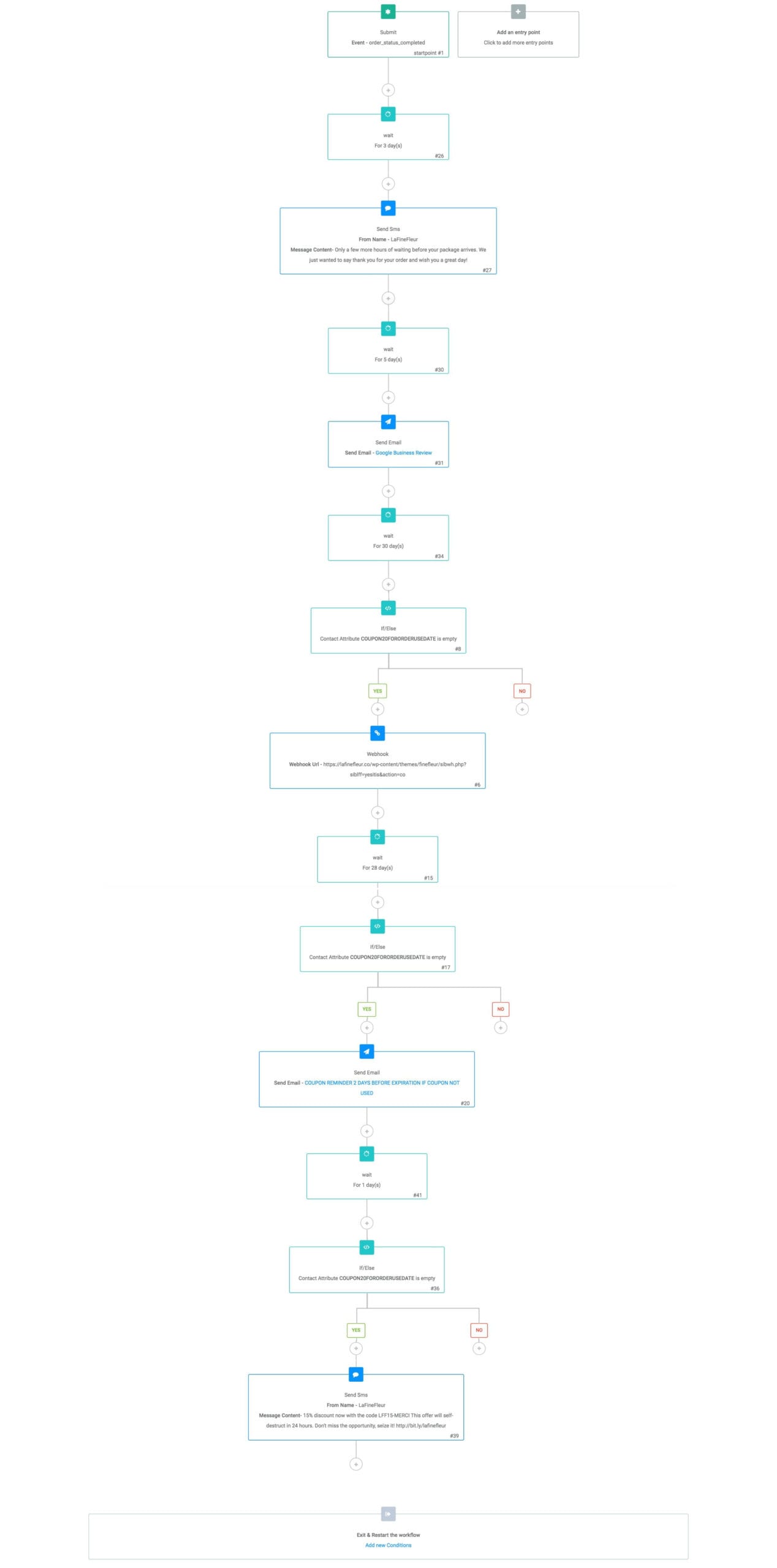
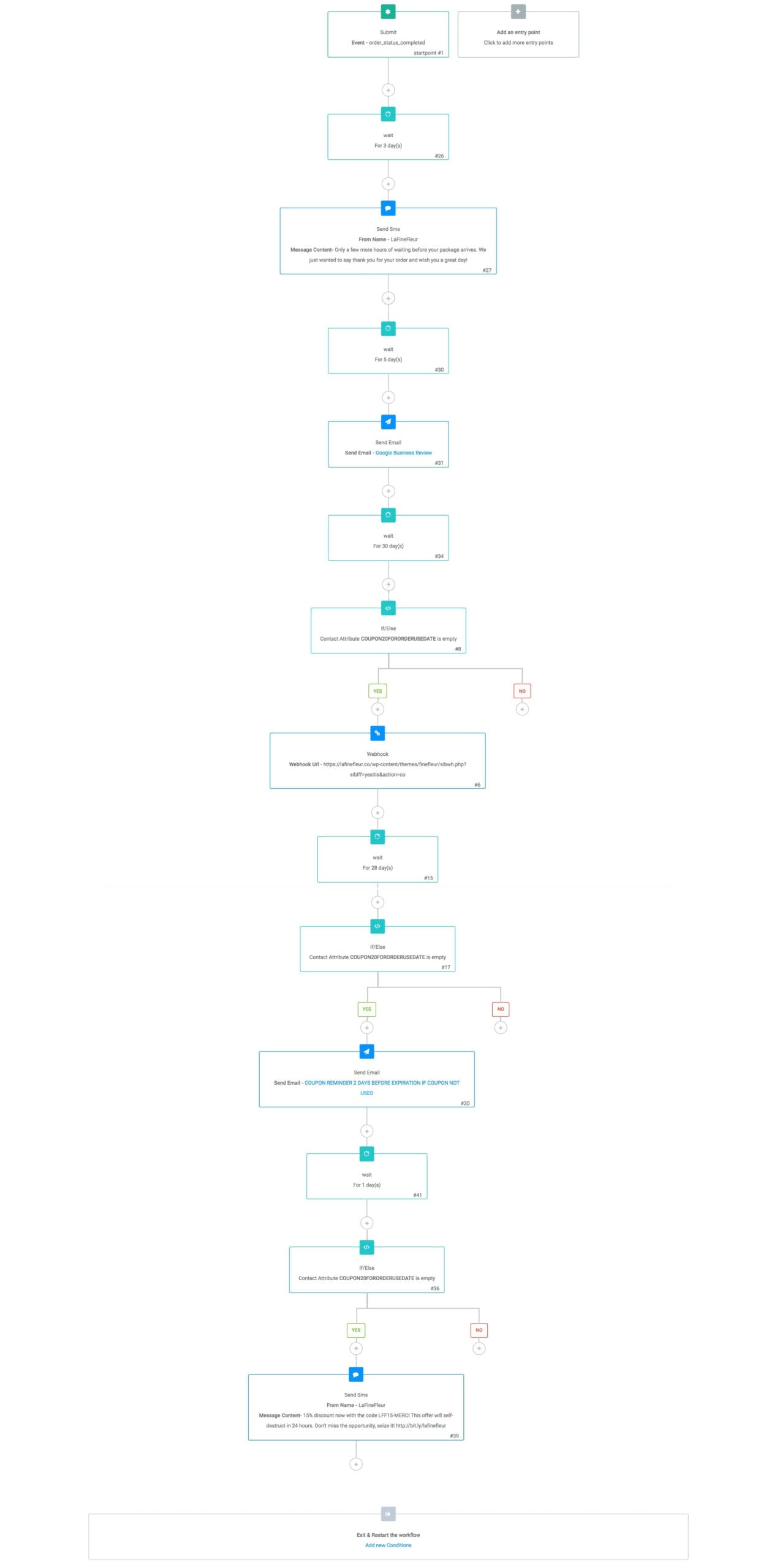
According to the above scenario:
- 3 days after the order is shipped, the customer receives a “thank you for your order message” (it was important for the client at this stage to show gratitude to the customer instead pushing a commercial message)
- 8 days after the order is shipped (i.e. the order has already been delivered), the customer receives an email request to leave a Google Business review (great opportunity to capitalize on the customer’s satisfaction to increase brand awareness)
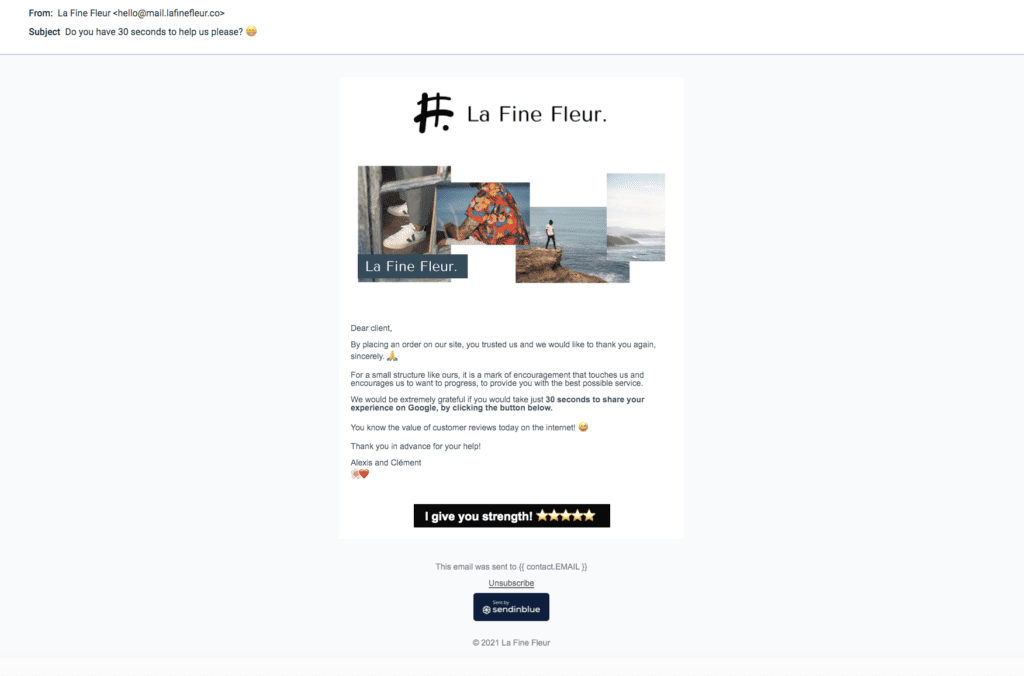
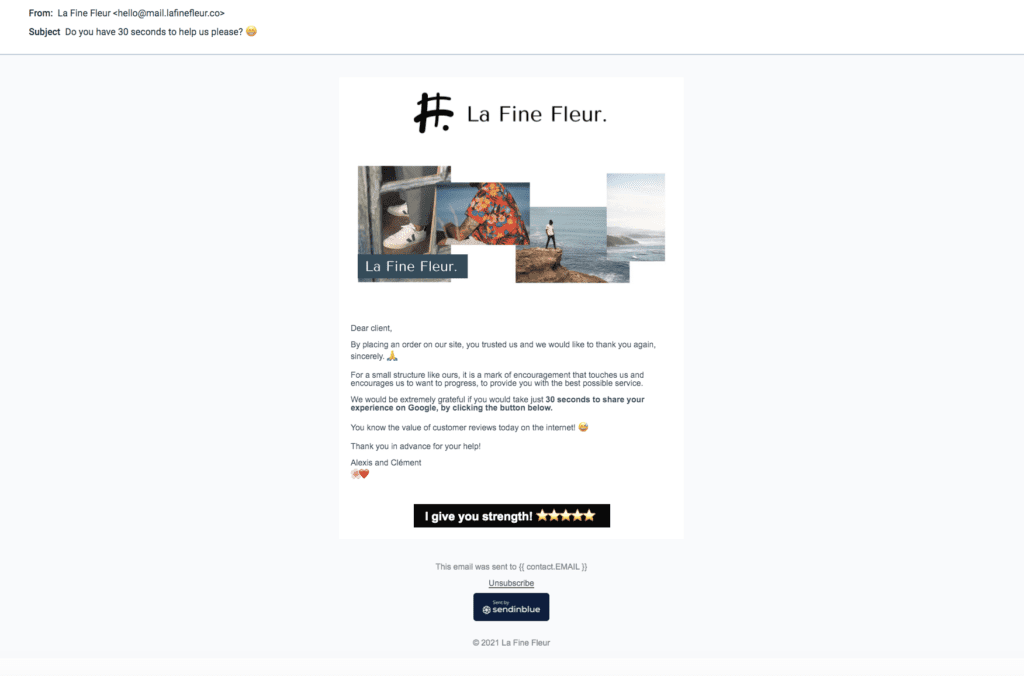
- 30 days later, the customer receives an email with a discount code valid for one month (setting time limits is a good way motivate users to make the new purchase, if they haven’t already)
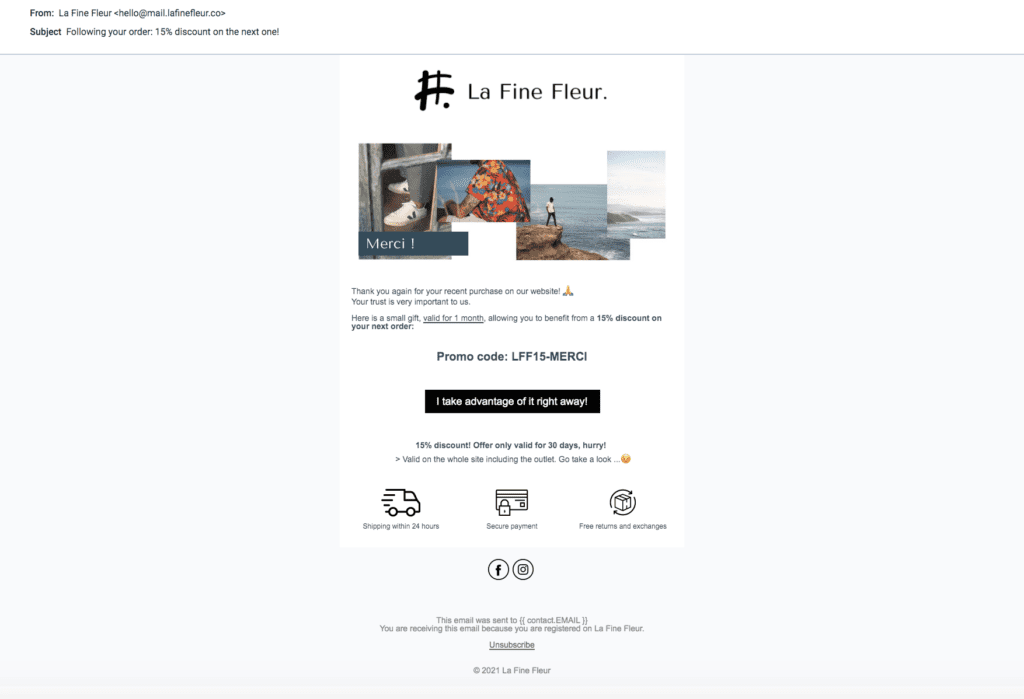
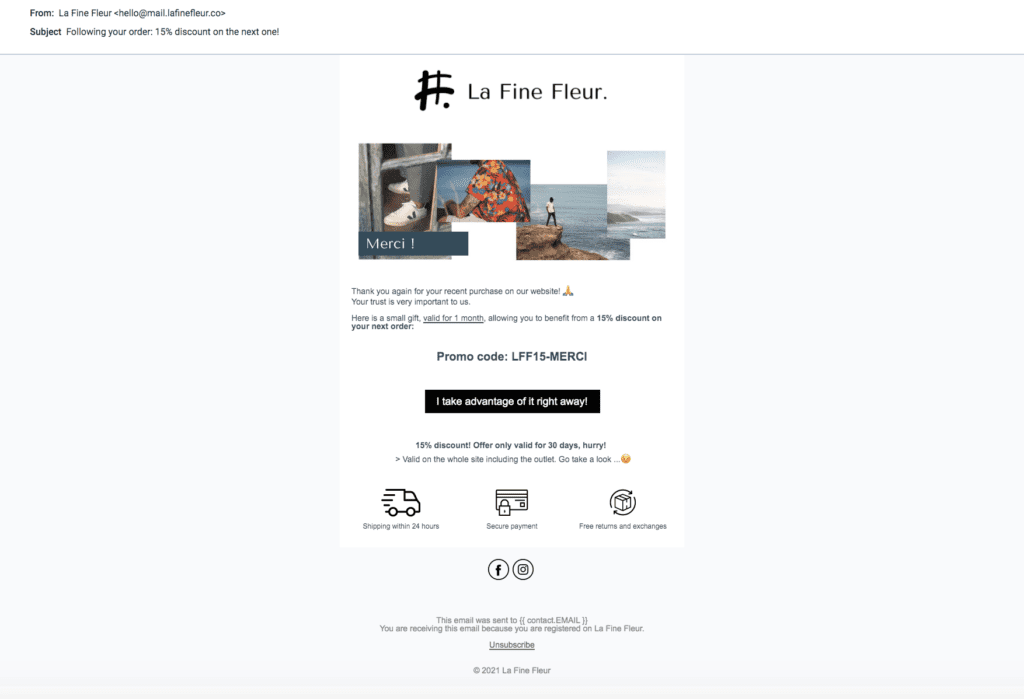
- 28 days later (i.e. 48 hours before the discount code expires), the user receives another email reminding them that the code will expire
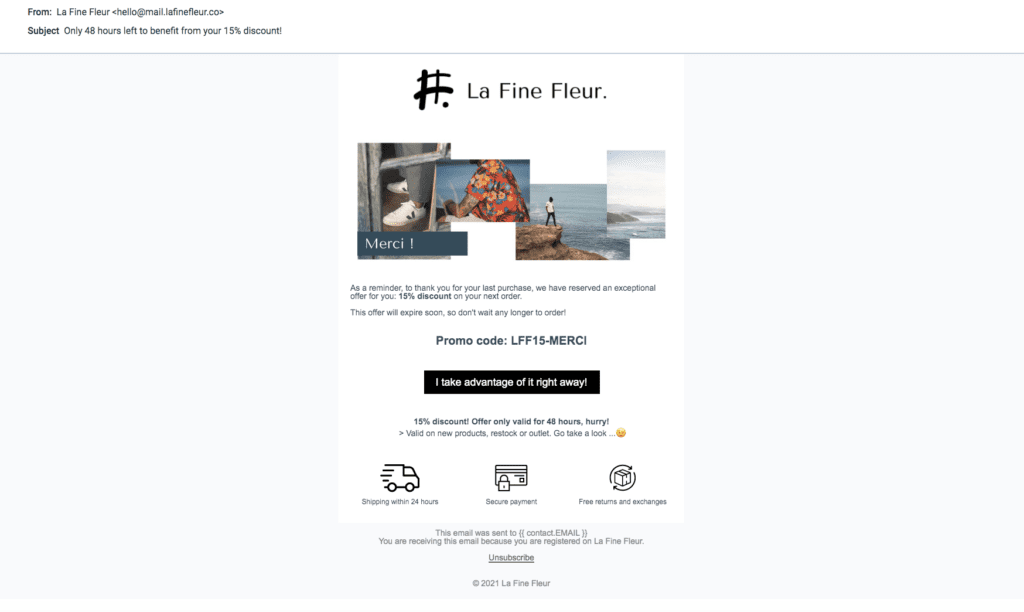
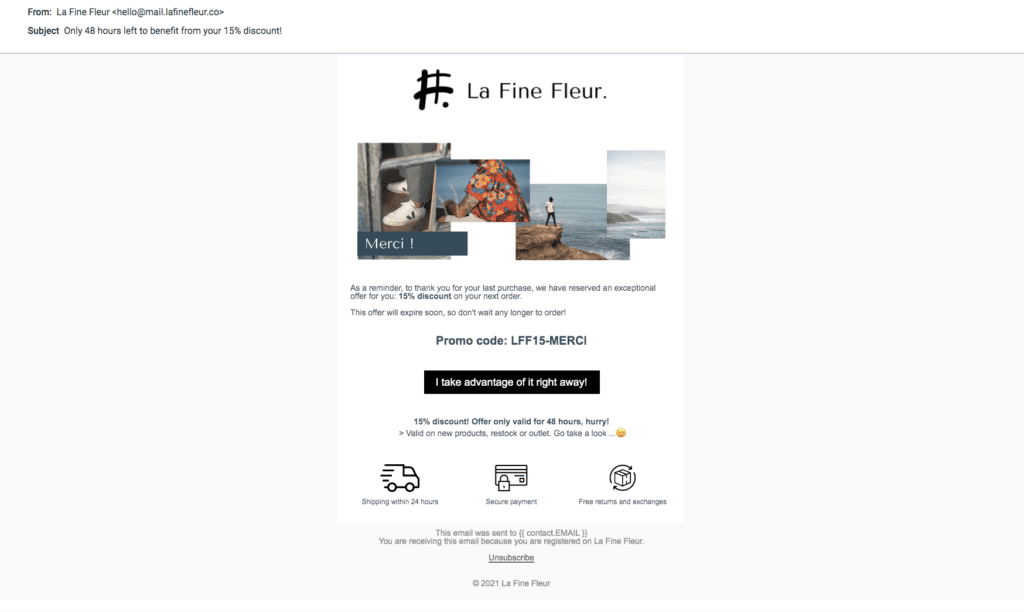
- 24 hours before the discount code expires, if it still hasn’t been used, the contact receives an SMS reminder (by now, there’s a sense of urgency which validates using SMS as a channel)
- 24 hours after the SMS reminder, the workflow verifies if the discount code has been used or not
A couple of key points to note:
- Some may argue that SMS is intrusive but these contacts are already customers and have opted-in to receive this type of communication. For La Fine Fleur, this is done via a checkbox on the checkout page.
- A tip is to explicitly let the customer know which methods of communication will be used and who will contact them (more often than not, user data is shared with partners and this makes potential customers wary of handing over contact details)


- Before setting up any automation workflows, it’s good practice to integrate relevant dynamic attributes to Sendinblue’s database and collect data on them over a certain period of time. Thi will give you ideas on how to use these attributes in the future. In the case of the workflow described above, relevant attributes include Order Status, Site Status (i.e. a customer’s status on the website), and an attribute related to the discount code.
- Speaking of the discount code attribute, it’s recommended to add the usage verification condition to the workflow after each single step in order to avoid irrelevant creative assets. For tracking purposes, it’s also good to have a custom code for each workflow. Please note that the discount code should also always be uniquely associated with the user’s email and not be valid otherwise.
- Since it’s impossible to track the open rate of SMS, the only way to collect any relevant data would be to integrate a shortened URL (bit.ly or similar). This way we could track the click rate and eventually measure the success of the campaign.
Workflow #2: Follow Up with Prospects
This second multi-step omnichannel workflow is primarily targeted at customers who’ve subscribed to the newsletter but haven’t ordered yet (i.e. warm leads).
It consists of email follow ups, importing contacts to a new list for a specific campaign, and Facebook Ads. La Fine Fleur’s goal with this workflow was to reactivate prospects who’ve shown an interest in the brand but haven’t converted.
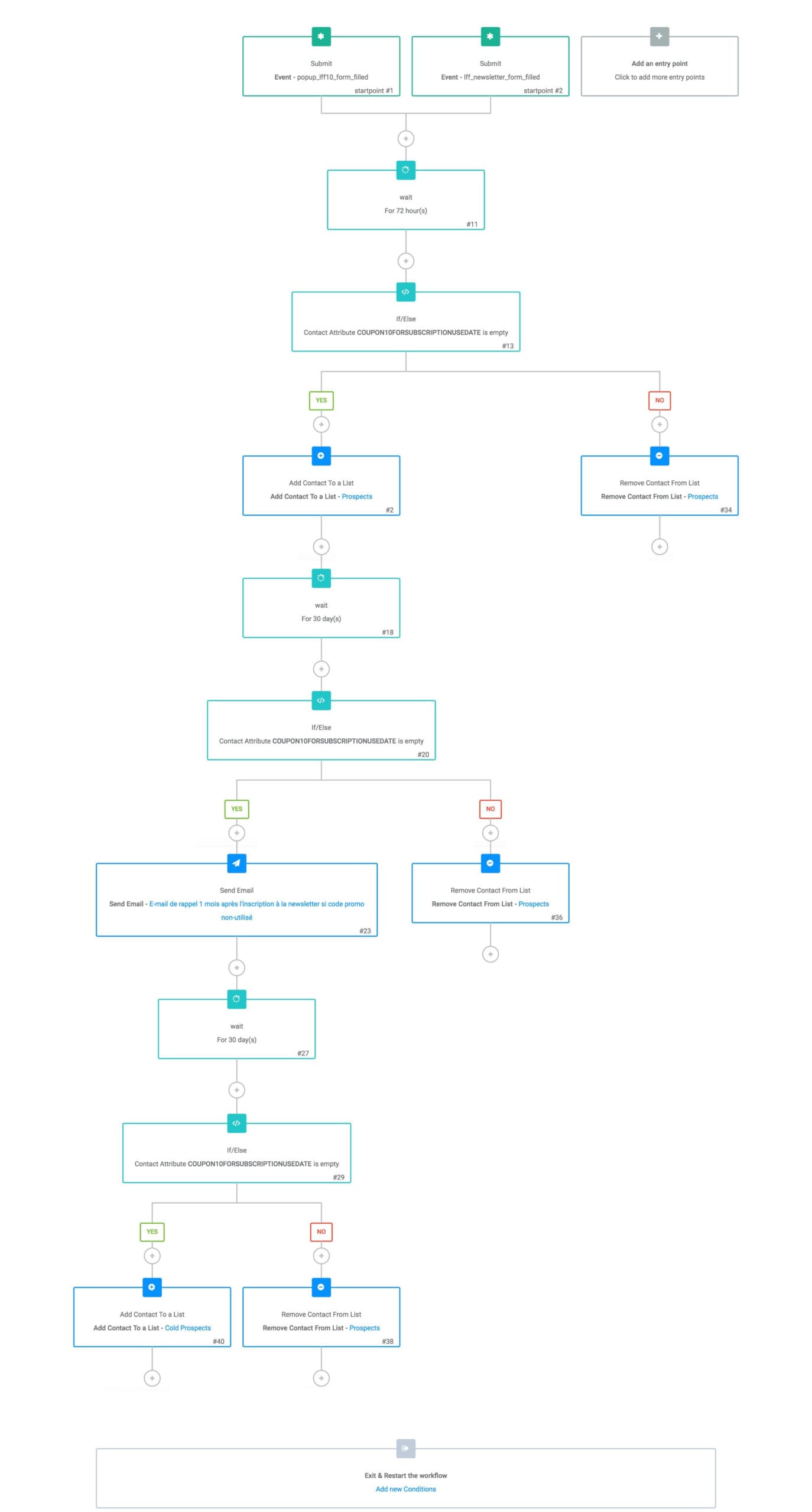
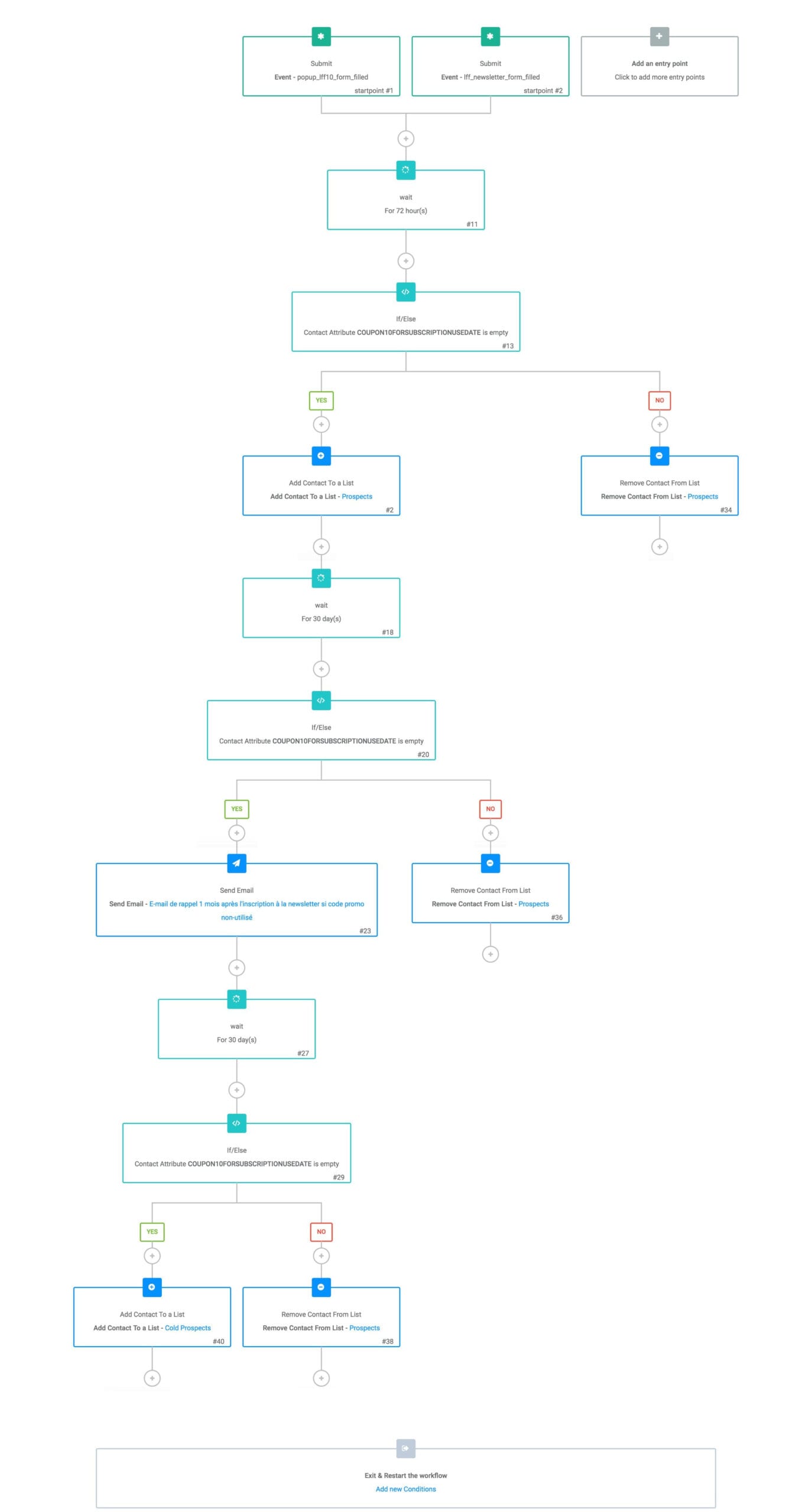
Upon signup, newsletter subscribers receive a discount code in their welcome email.
Following the scenario above:
- 72 hours after newsletter subscription (multiple email capture points via popup, header and footer), if the promotional code provided in the newsletter subscription confirmation email was not used (i.e. the order was not passed within a period of 3 days following subscription to the newsletter), the users are automatically added to list ‘Prospects’
- At this stage, we manually launch and configure a Facebook ad on Sendinblue to be shown to the ‘Prospects’ list for 14 days. Note that “Include your contact lists as part of your audience” requires a minimum of 20 contacts. The ad format was a single image with a message inviting the prospect to discover the brand and its values, as well as a discount code reminder and a ‘Shop Now’ CTA.
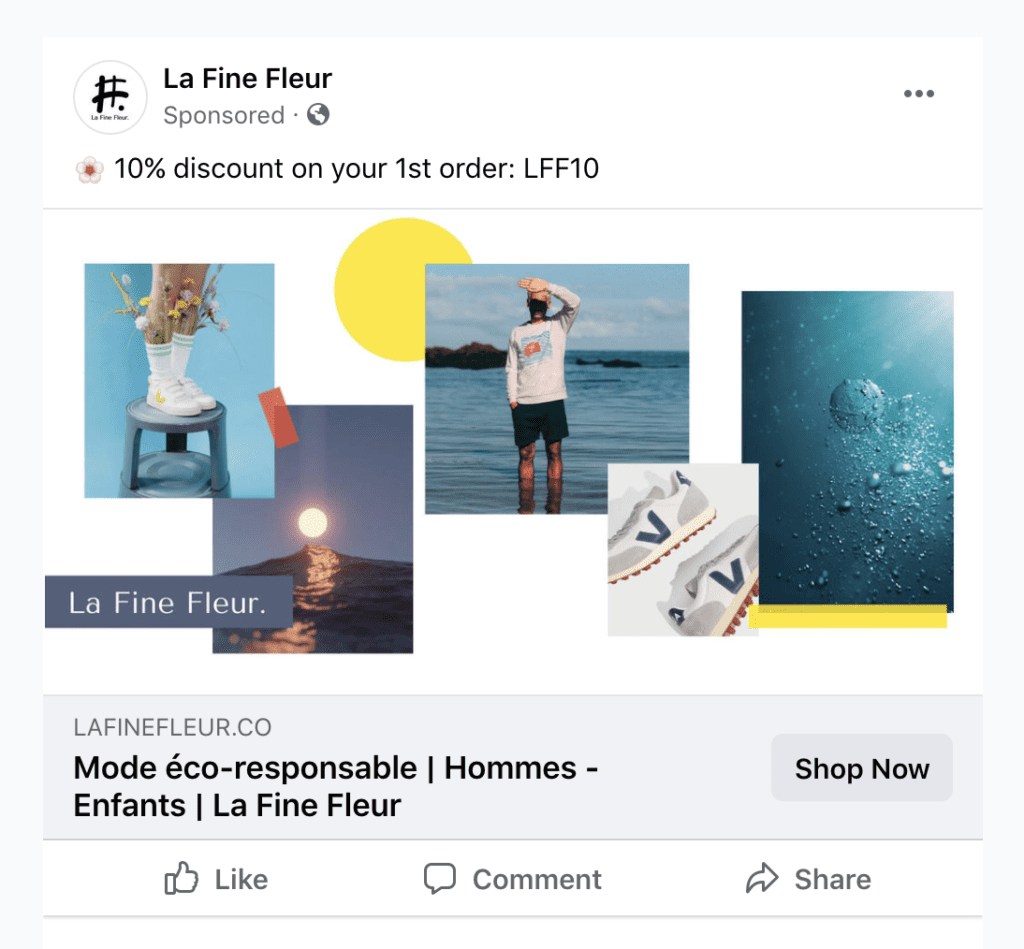
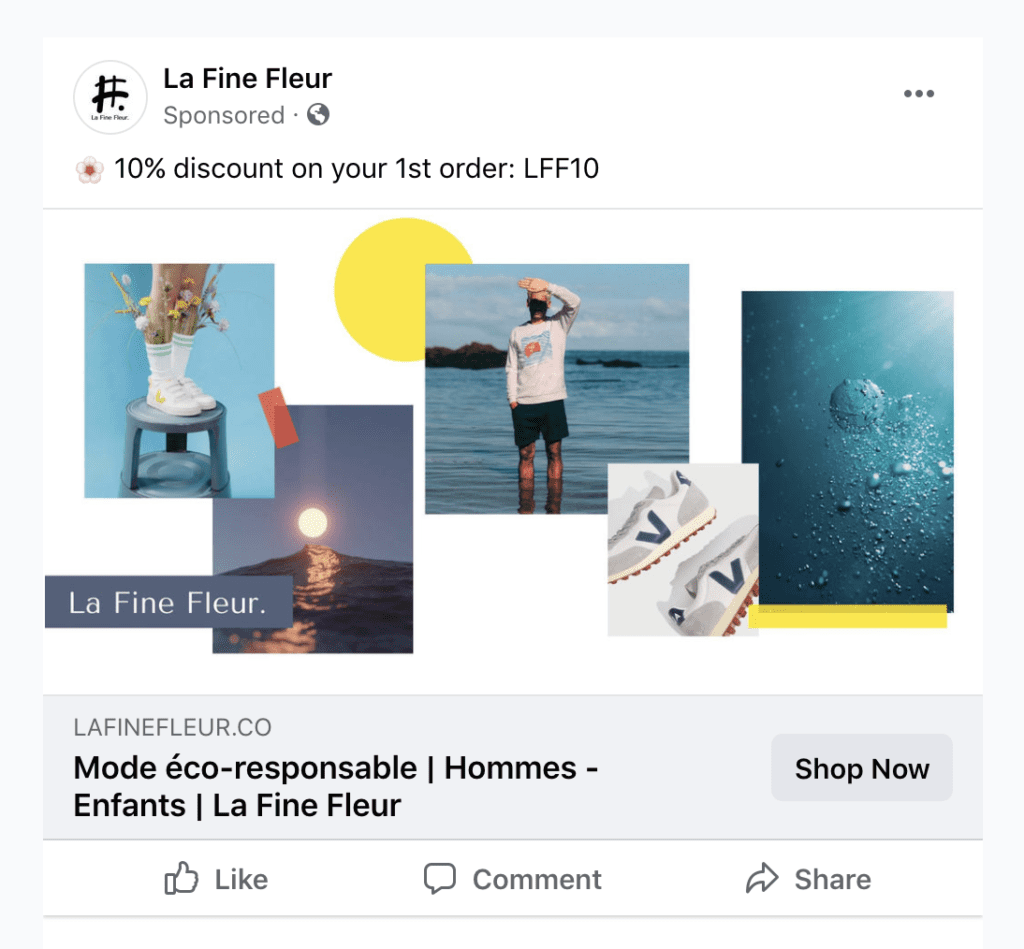
- At the end of the Facebook Ad campaign (i.e. 14 days later), the workflow verifies if the discount code has been used. If yes, the contact is removed from the ‘Prospects’ list.
- If the discount code hasn’t been used, the user receives an email reminder with the same discount code 16 days after the ad campaign (i.e. 30 days after contact was initially added to the ‘Prospects’ list).
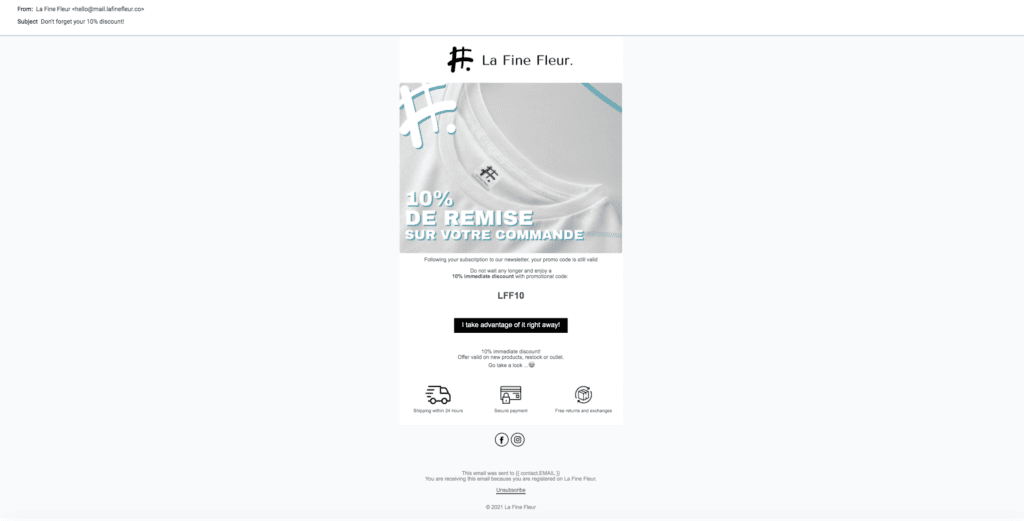
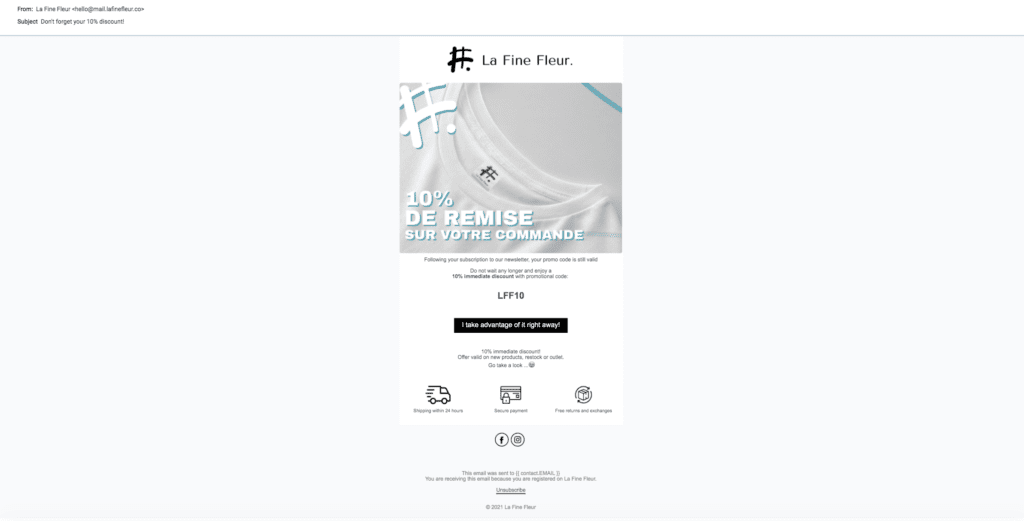
- Wait 30 days then verify again if the promotional code has been finally used. If yes, the contact should be removed from list ‘Prospects‘ and moved to ‘Clients‘. If not, moved the contact to the list ‘Cold Prospects‘. Given that contacts can only enter this workflow once, it leaves an opportunity to eventually start another workflow.
A few key aspects to pay attention to:
- Facebook Ads can’t be integrated into automation workflows and have to be launched manually;
- When lists are segmented based on contact activity, as was the case for La Fine Fleur’s ‘Prospects’ list, it’s good practice to verify if the condition to be in this list is fulfilled after each step, resulting in users being removed from the list if the answer is «yes».
Bonus: Facebook Ads targeted to audiences similar to lists «Clients» and «Prospects»
This Facebook Ad campaign is supposed to compliment the previously mentioned automated workflows. The Facebook Ad is shown to a lookalike audience over a 10-day period and in terms of content focuses on brand discovery. Facebook’s intelligent targeting allows it to find more potential customers with similar interests and characteristics.
It’s important to note that at least 500 contacts must be selected to target audiences similar to your lists.
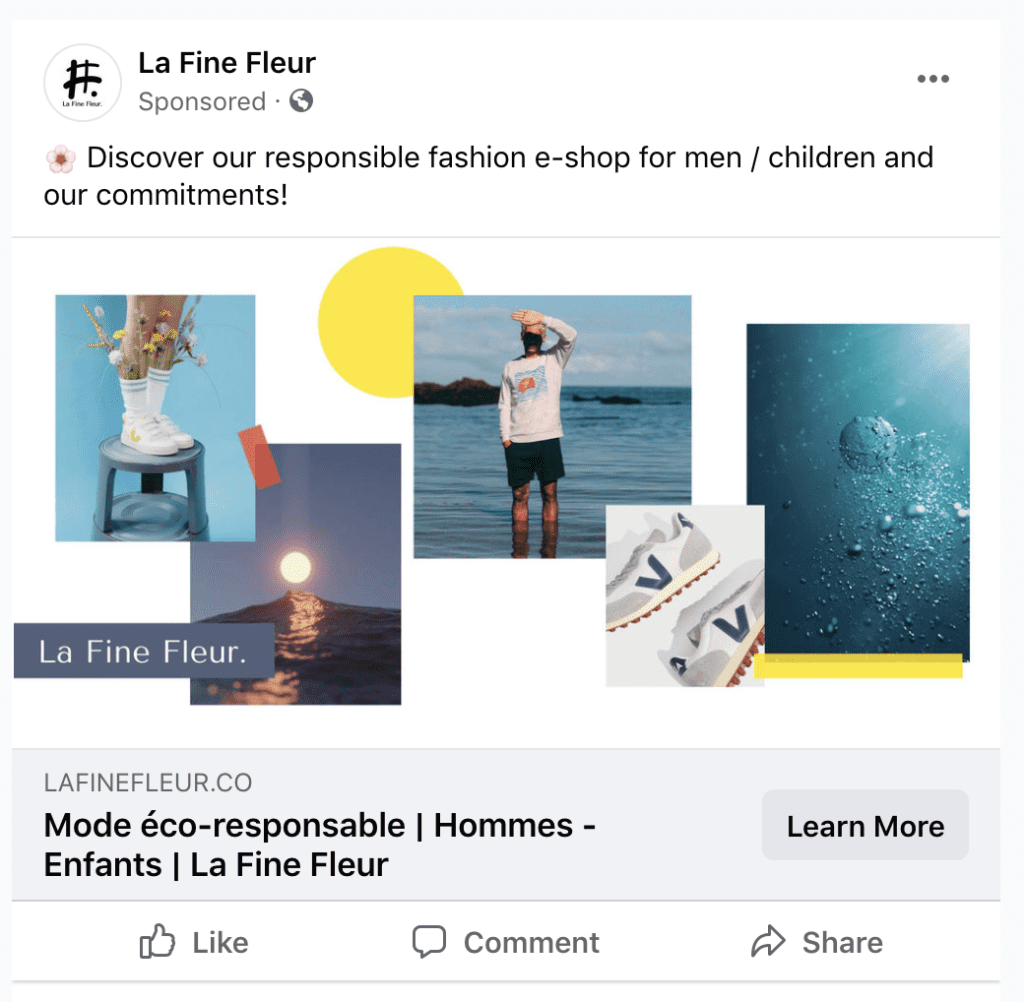
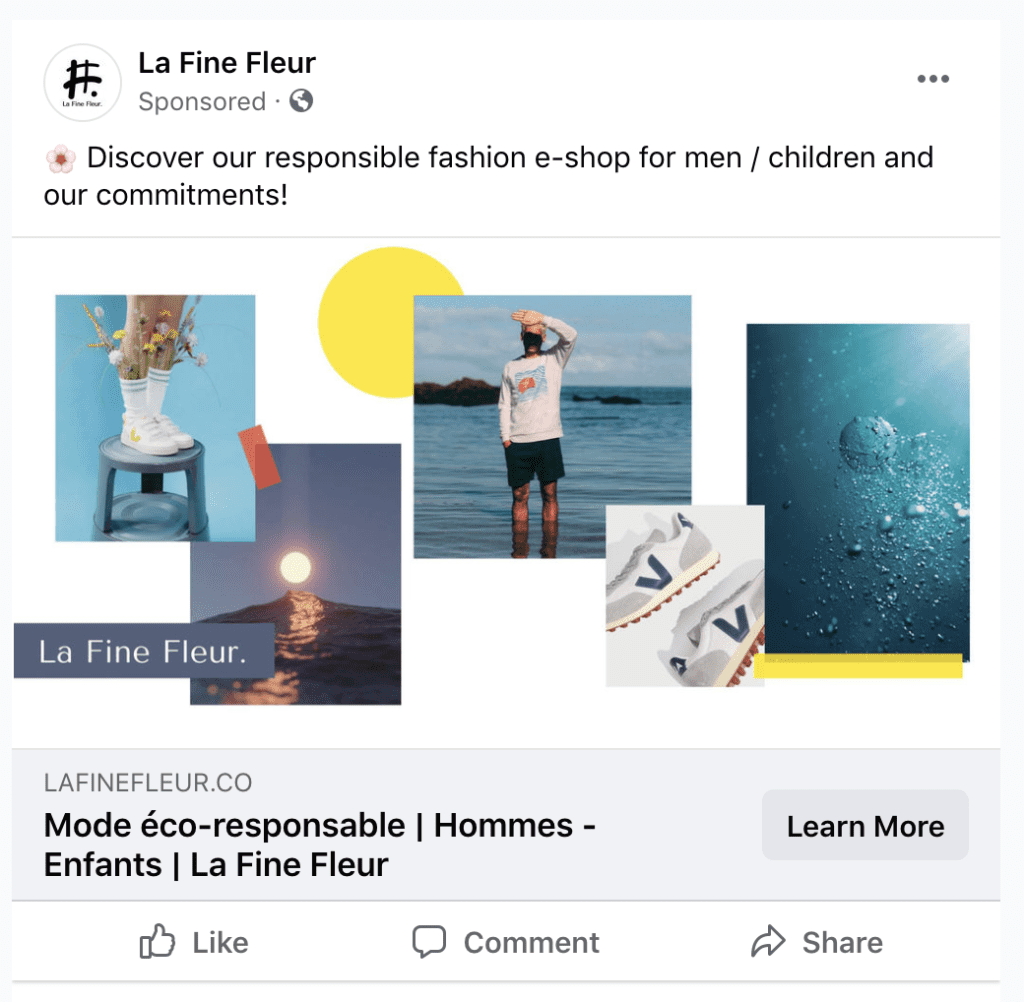
Results
Implementing these two omnichannel workflows with marketing automation (as well as Facebook Ads), allowed La Fine Fleur to activate their prospects and re-engage their existing customers.
There’s no doubt that Sendinblue played a critical role in helping La Fine Fleur reach their objectives and boost their ROI. So much so that it’s become a cornerstone in La Fine Fleur’s digital marketing strategy:
- 29% of La Fine Fleur’s web traffic comes from emails sent via Sendinblue
- 31% of its conversions are generated via Sendinblue
- In terms of ecommerce shopping behaviour, 64.23% are returning visitors
- When it comes to ecommerce checkout behaviour, 39.6% of sessions have transactions
- For ecommerce sales performance, 54.65% of revenue is generated by returning customers
Conclusion
Sendinblue’s marketing automation platform is a powerful and robust relationship marketing solution. Its omnichannel features allow brands to create individualized experiences for each contact. If you want to create an automated conversion machine with advanced workflows, Sendinblue’s your tool for the job!
Boost your client projects with SendinblueInspired by the amazing success of Rocket Conseil? Join our Expert Program and make your clients thrive digitally with Sendinblue. |
And what’s next for Rocket Conseil and La Fine Fleur you ask? A couple of things:
- Integrating Sendinblue’s chat feature into the existing marketing automation strategy
- Adding lead scoring to the purchase process to create an advanced onboarding flow that’ll adapt to the contact’s behavior and needs
Do you too want to boost your company’s ROI through omnichannel marketing? If yes, contact Rocket Conseil’s team today.
 Deutsch
Deutsch




















